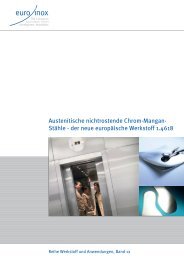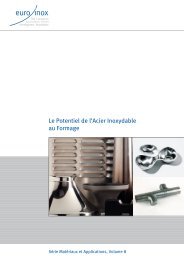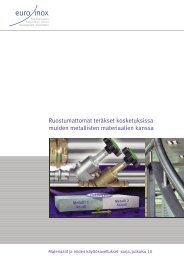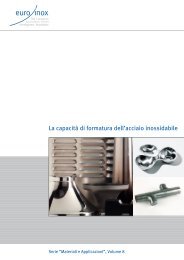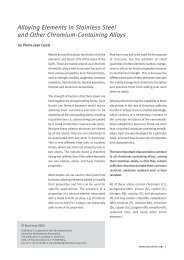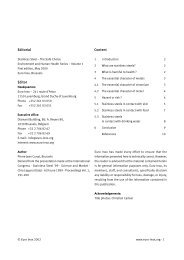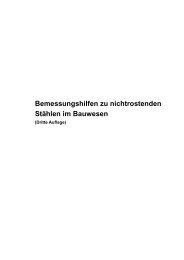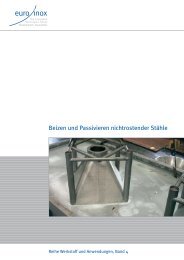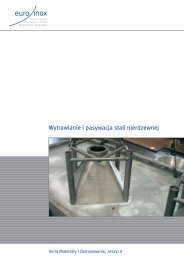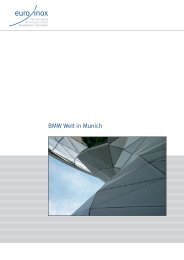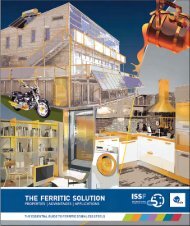Innovative Stainless Steel Applications in transport ... - Euro Inox
Innovative Stainless Steel Applications in transport ... - Euro Inox
Innovative Stainless Steel Applications in transport ... - Euro Inox
Create successful ePaper yourself
Turn your PDF publications into a flip-book with our unique Google optimized e-Paper software.
Comb<strong>in</strong>ed with modern puls<strong>in</strong>g techniques, considerable heat-<strong>in</strong>put reduction has been<br />
achieved with these arc braz<strong>in</strong>g methods.<br />
MAG weld<strong>in</strong>g with tubular cored filler wire – i.e. flux cored arc weld<strong>in</strong>g (FCAW) or<br />
metal cored (MCAW) arc weld<strong>in</strong>g – is a MIG/MAG variant <strong>in</strong> which solid filler metal<br />
wire is replaced by hollow filler wire. Flux cored wire is filled with gas and slag<br />
formers similar to those used <strong>in</strong> SMA electrode coat<strong>in</strong>g – hence the expression “<strong>in</strong>sideout<br />
stick electrode”. Alternatively, the wire electrode can be filled with metal powder,<br />
for <strong>in</strong>creased filler-metal deposition rate and productivity. Advantages over MIG/MAG<br />
are improved productivity (deposition rate kg/h), improved penetration and protection<br />
aga<strong>in</strong>st certa<strong>in</strong> weld defects, such as porosity. The productivity of MIG/MAG processes<br />
with solid or tubular wire can be further improved by us<strong>in</strong>g two or more wires <strong>in</strong>stead of<br />
one. The most common versions are tw<strong>in</strong> arc, where one source powers two wires, and<br />
tandem, where two wires are powered by two separate sources.<br />
Submerged arc weld<strong>in</strong>g (SAW)<br />
Even higher deposition rates can be reached with submerged arc weld<strong>in</strong>g (SAW), which<br />
is not a gas arc method but a technique of its own. As with MIG/MAG, the arc is<br />
formed between a cont<strong>in</strong>uous consumable wire electrode and the workpiece, but <strong>in</strong>stead<br />
of a shield<strong>in</strong>g gas, the molten filler metal and weld pool are protected by a layer of flux<br />
powder. This flux consists of metal powders and elements also found <strong>in</strong> SMA electrode<br />
coat<strong>in</strong>g and MAG flux cored electrode wires, that form both shield<strong>in</strong>g gases and<br />
protective slag. Productivity can be further <strong>in</strong>creased by us<strong>in</strong>g multiple wires and power<br />
sources – up to six have been reported – or by feed<strong>in</strong>g metal powder <strong>in</strong>to the weld pool.<br />
A typical use for all these high-productivity methods is thick-section weld<strong>in</strong>g of mild<br />
and sta<strong>in</strong>less steel. The process cannot be performed manually and the weld<strong>in</strong>g position<br />
is limited to flat, horizontal or horizontal-vertical. Overhead weld<strong>in</strong>g is not feasible.<br />
SAWs tend to have a higher heat <strong>in</strong>put and thus a slower cool<strong>in</strong>g rate than the other<br />
processes described here.<br />
Tungsten <strong>in</strong>ert gas weld<strong>in</strong>g (TIG)<br />
Tungsten <strong>in</strong>ert gas weld<strong>in</strong>g (TIG) or gas tungsten arc weld<strong>in</strong>g (GTAW) is also a gas arc<br />
process, where an electric arc is formed between a non-consumable tungsten electrode<br />
and the workpiece. The weld pool and possible filler metal are protected by an <strong>in</strong>ert<br />
shield<strong>in</strong>g gas. Tungsten –possibly with small alloy<strong>in</strong>g additions – is used for the<br />
electrode, because of its high melt<strong>in</strong>g po<strong>in</strong>t of around 3400 °C. The weld zone and<br />
electrode are protected by an <strong>in</strong>ert shield<strong>in</strong>g gas. TIG weld<strong>in</strong>g can be carried out either<br />
autogenously (i.e. without filler wire addition) or with filler wire. In manual TIG<br />
weld<strong>in</strong>g, the filler wire rod, typically ø 1.6 to 3.2 mm and 1 m long, is fed <strong>in</strong>to the weld<br />
pool with one hand while the torch is held <strong>in</strong> the other. In mechanised TIG weld<strong>in</strong>g, a<br />
cont<strong>in</strong>uous wire filler metal is automatically fed <strong>in</strong>to the weld zone. The productivity of<br />
84



